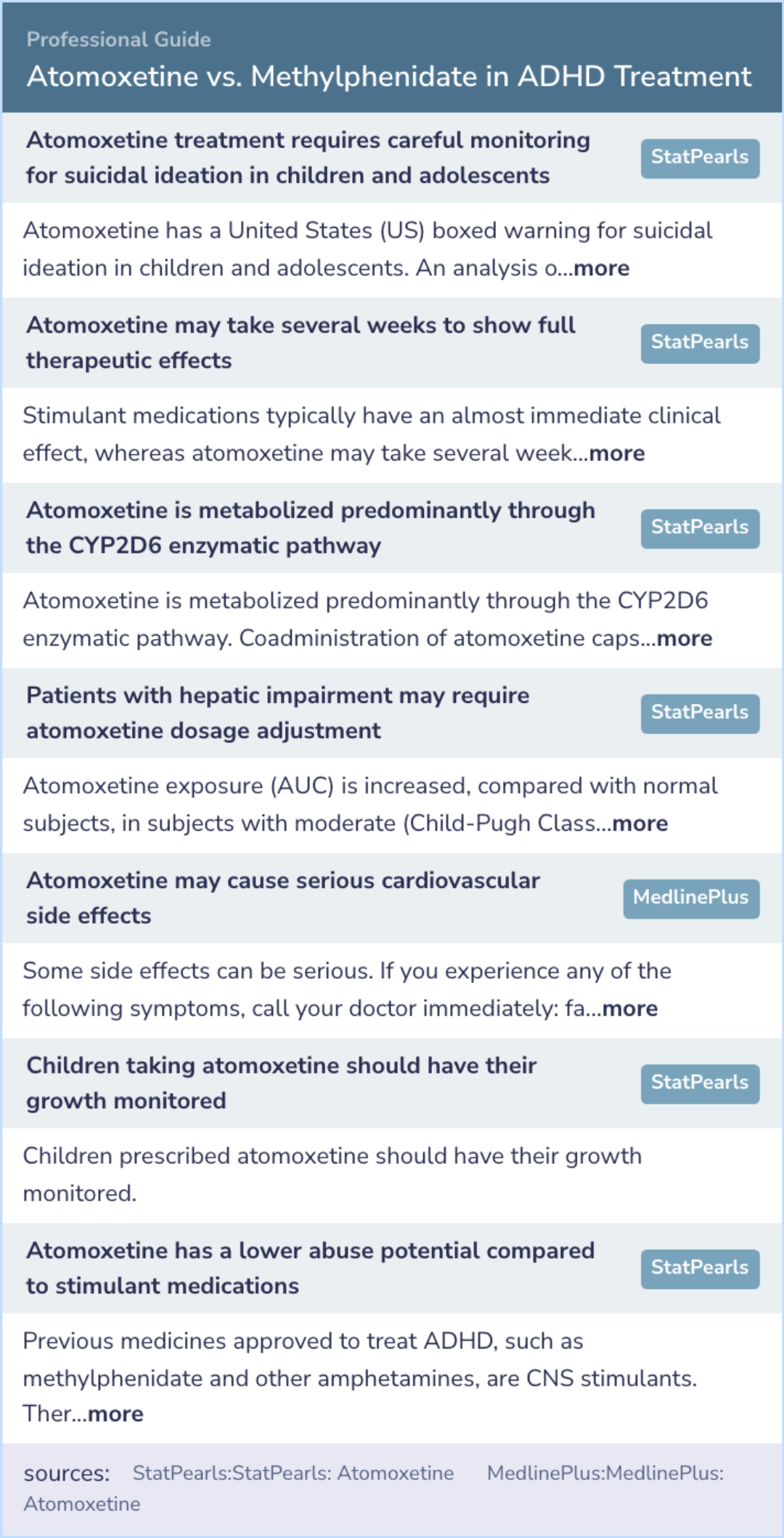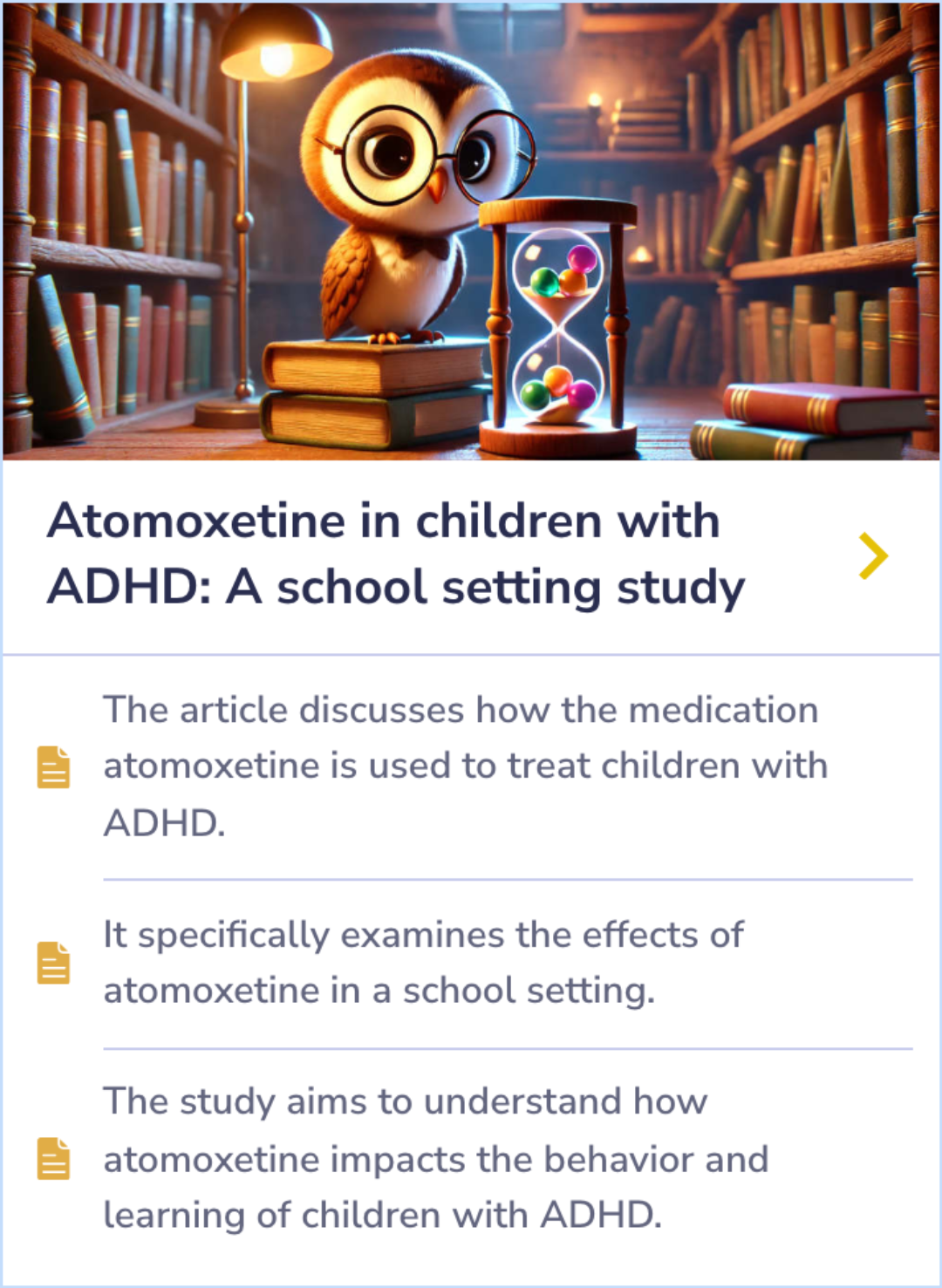Strattera Paper Database
Visual Abstract
Atomoxetine and methylphenidate treatment in children with ADHD: the efficacy, tolerability and effects on executive functions
Atomoxetine vs. Methylphenidate in ADHD Treatment
September 17, 2024
author
Yildiz O, Sismanlar SG, Memik NC, Karakaya I, Agaoglu B
journal
Child Psychiatry Hum Dev
Date Published
2011 Jun
Why link to a visual abstract?
What is a visual abstract?
Original
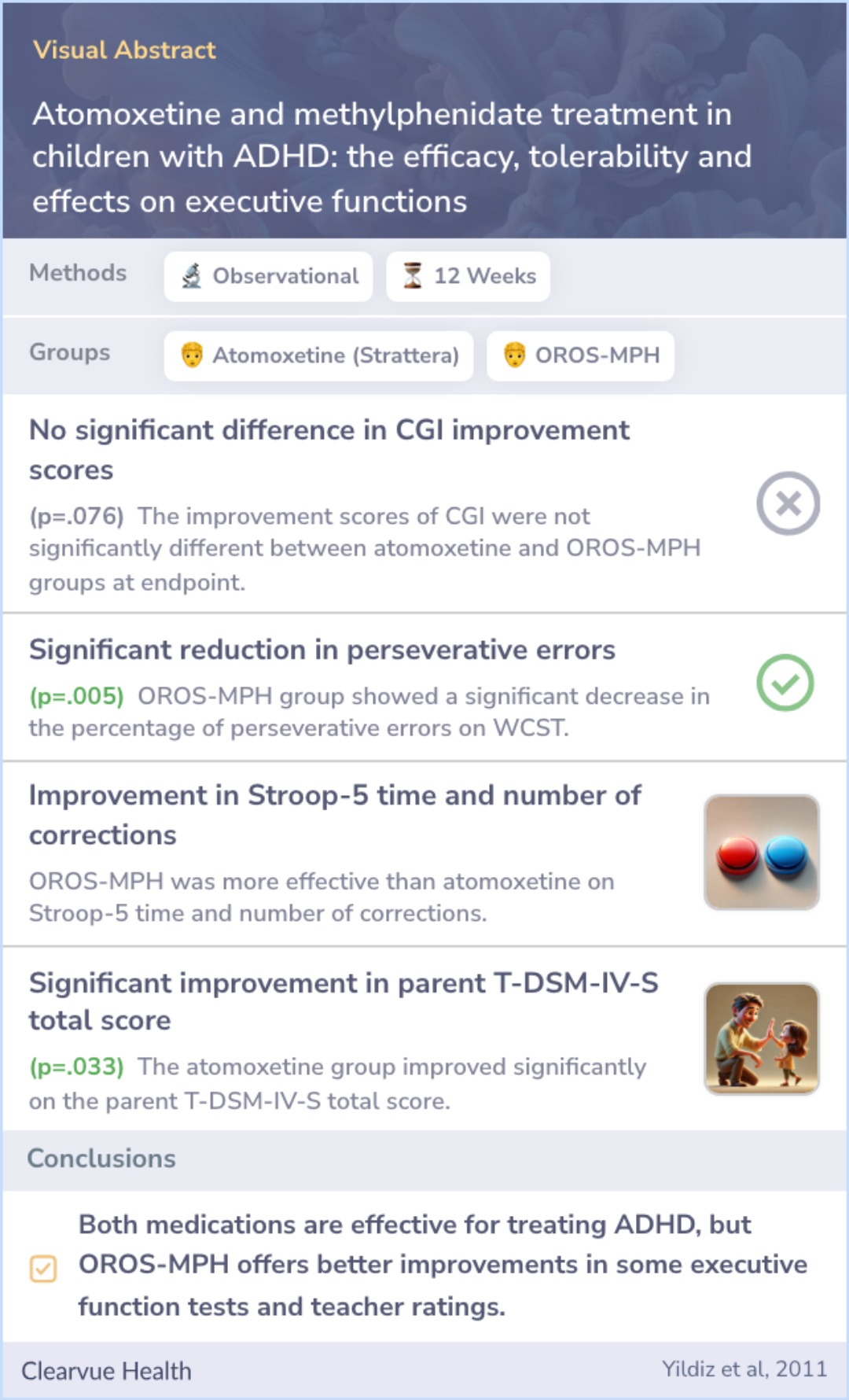
Study Summary
🔬
What They Studied
The main question was to compare the safety, efficacy, and effects on executive functions of atomoxetine (Strattera) and OROS-MPH in children with ADHD.
💡
What They Found
Both medications were effective for treating ADHD, but OROS-MPH showed greater improvements in some executive functions and informant scores.
📚
What This Means
These findings suggest that while both atomoxetine (Strattera) and OROS-MPH are effective for treating ADHD, OROS-MPH may offer superior benefits in certain areas, consistent with current guidelines recommending a comprehensive treatment approach for ADHD.
Study Summary
Study Overview
This study aimed to explore how well atomoxetine and OROS-MPH treat ADHD by looking at both safety and effectiveness. The research gathered feedback from teachers, clinicians, and parents, providing a broader view of treatment outcomes.
The findings indicated that both medications showed significant improvements in executive functions. Notably, OROS-MPH demonstrated more marked improvements, suggesting a potential advantage over atomoxetine in ADHD treatment.
The findings indicated that both medications showed significant improvements in executive functions. Notably, OROS-MPH demonstrated more marked improvements, suggesting a potential advantage over atomoxetine in ADHD treatment.
Abstract: background
The aim of this study was to compare the safety, efficacy, tolerability, and the effects of atomoxetine and OROS-MPH on executive functions in children with ADHD.

Study Findings on ADHD Treatment
"As the result of our study, which included feedback from teachers in addition to clinician and parent ratings unlike the other studies, it can be concluded that while both drugs were effective in ADHD treatment, OROS-MPH provided a more marked improvement on the symptoms."
Assessment of Treatment Efficacy
"An important aspect of our study is that treatment efficacy was assessed with neuropsychological tests battery."
General Tolerance of Medications
"It is considered that both atomoxetine and OROS-MPH were generally well tolerated, with few discontinuations due to adverse events."
Study Summary
Methods
In this study, children with ADHD were randomly assigned to receive either atomoxetine (Strattera) or OROS-MPH (Concerta) for 12 weeks. The study was open-label, meaning both doctors and participants knew which medication they were taking.
Researchers measured effectiveness using ADHD symptom scales and neuropsychological tests. Safety checks included heart tests, a list of possible side effects, and blood work to ensure the medications were not causing harm.
Researchers measured effectiveness using ADHD symptom scales and neuropsychological tests. Safety checks included heart tests, a list of possible side effects, and blood work to ensure the medications were not causing harm.
Abstract: methods
This study was an open-label study that only included two medication groups. Children were randomized to open-label atomoxetine or OROS-MPH for 12 weeks. Primary efficacy measures were T-DSM-IV-S, CGI-I and neuropsychological tests battery. Safety as...more

Study Summary
Results
The study found no significant differences in overall treatment responses between the two medications according to parent and clinician ratings. However, OROS-MPH (Concerta) showed more effectiveness in reducing teacher-rated ADHD symptoms and improved certain cognitive tests.
OSRO-MPH was particularly better in tasks measuring reaction time and error correction. The most common side effects for atomoxetine included loss of appetite, nausea, and weight loss. For OROS-MPH, they included similar issues such as anorexia and insomnia.
OSRO-MPH was particularly better in tasks measuring reaction time and error correction. The most common side effects for atomoxetine included loss of appetite, nausea, and weight loss. For OROS-MPH, they included similar issues such as anorexia and insomnia.
Abstract: results
According to the endpoint improvement scores of CGI and parents T-DSM-IV-S, treatment responses were not significantly different between the two study groups. OROS-MPH led to a significantly greater reduction in teacher T-DSM-IV-S scale scores. OROS-...more
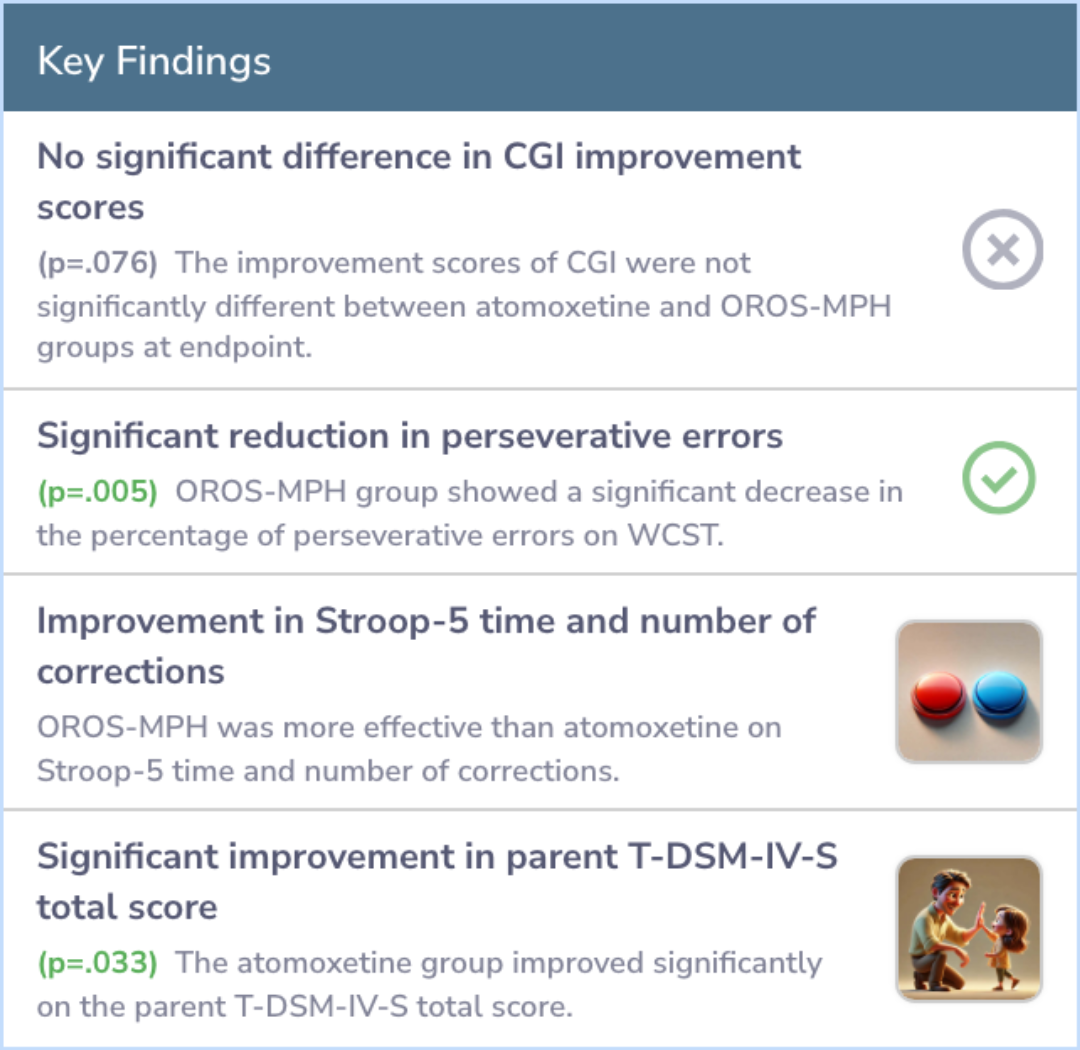
Study Summary
Conclusions
Both atomoxetine (Strattera) and OROS-MPH (Concerta) are effective in treating children with ADHD, but OROS-MPH may offer more noticeable improvements according to teachers and specific cognitive tests.
While both medications had similar types of side effects, OROS-MPH seemed to help more with certain executive functions, making it a potentially better choice for some children.
While both medications had similar types of side effects, OROS-MPH seemed to help more with certain executive functions, making it a potentially better choice for some children.
Abstract: conclusions
When all these results are considered, although both drugs can be considered effective in ADHD treatment, more remarkable improvement is provided by OROS-MPH based on the rates across informant (i.e., teachers, clinicians) and neuropsychological eval...more
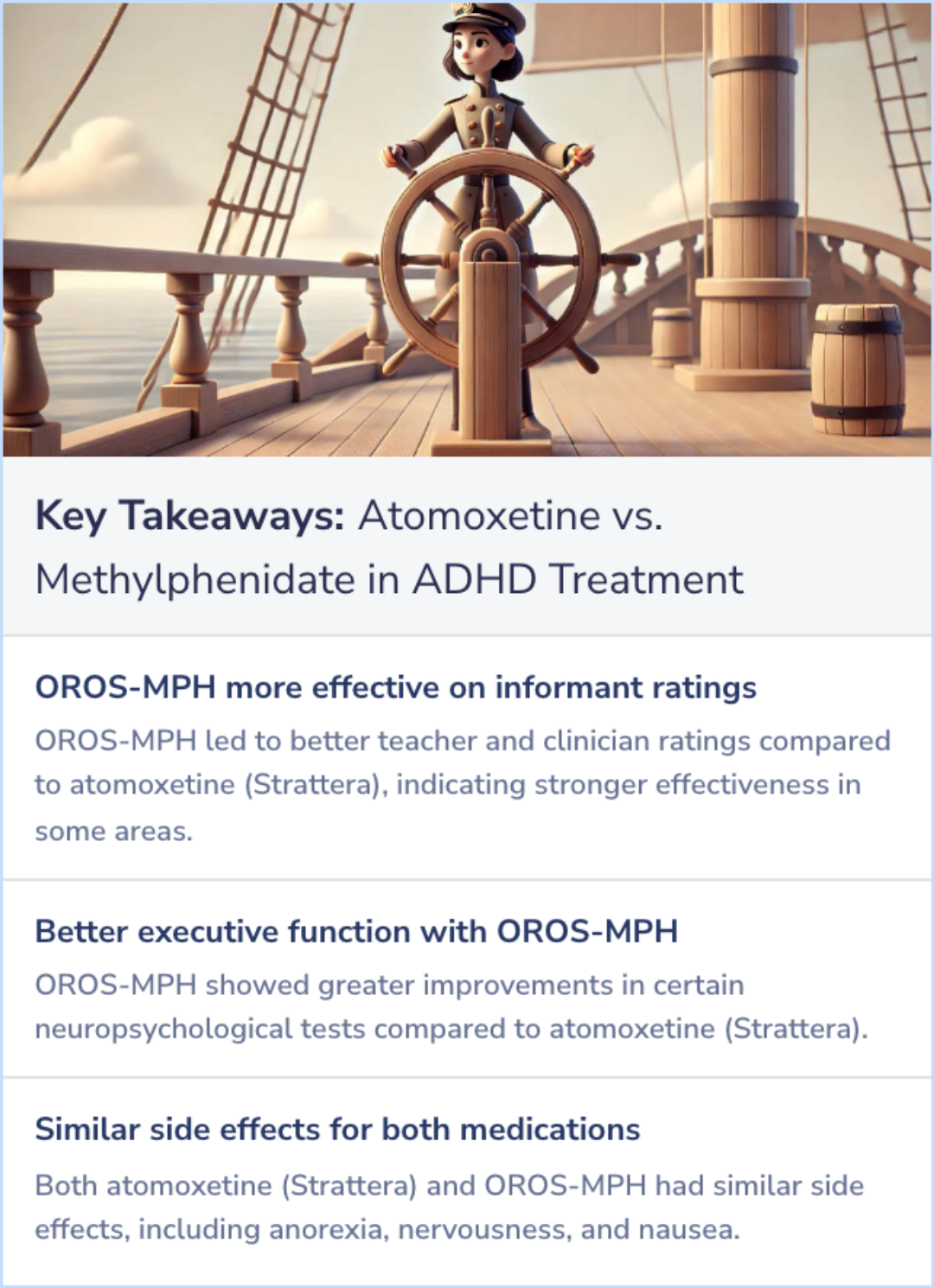
Background Information
Patient Guide
💊
FDA-Approved Treatment
Strattera (atomoxetine) is FDA-approved for treating ADHD in children over six years old.
⚙️
Mechanism of Action
Atomoxetine is a selective norepinephrine reuptake inhibitor, impacting dopamine in specific brain regions.
🧠
Neuropsychological Monitoring
Atomoxetine patients need monitoring for psychiatric symptoms and potential effects on growth in children.
🤕
Common Adverse Effects
Frequently reported side effects of atomoxetine include headache, insomnia, nausea, and decreased appetite.
⚠️
Safety Concerns
Atomoxetine includes a boxed warning for suicidal ideation in children and risks of cardiovascular events.

Professional Guide
Expert Opinion: Atomoxetine vs. Methylphenidate in ADHD Treatment
In light of the study's findings on atomoxetine and OROS-MPH, it is noteworthy that atomoxetine requires careful monitoring for suicidal ideation in children and adolescents.
This medication may take several weeks to show its full therapeutic effects compared to stimulant medications.
Additionally, atomoxetine is metabolized through the CYP2D6 pathway, necessitating dosage adjustments when administered with CYP2D6 inhibitors.
Patients with hepatic impairment also require dosage adjustments due to increased atomoxetine exposure.
It is also important to monitor children on atomoxetine for growth and cardiovascular side effects.
Despite these considerations, atomoxetine has a lower abuse potential compared to stimulant medications, which may influence its use within a comprehensive ADHD treatment program.
This medication may take several weeks to show its full therapeutic effects compared to stimulant medications.
Additionally, atomoxetine is metabolized through the CYP2D6 pathway, necessitating dosage adjustments when administered with CYP2D6 inhibitors.
Patients with hepatic impairment also require dosage adjustments due to increased atomoxetine exposure.
It is also important to monitor children on atomoxetine for growth and cardiovascular side effects.
Despite these considerations, atomoxetine has a lower abuse potential compared to stimulant medications, which may influence its use within a comprehensive ADHD treatment program.
Evidence Summary
Comparing Methylphenidate and Atomoxetine for ADHD
Both methylphenidate and atomoxetine are used to manage ADHD symptoms in individuals. The comparison focuses on their roles and differences in treatment, looking at which medication might be more beneficial for those with ADHD.
Effectiveness and differences between the two drugs are the primary points of discussion. Each medication has its unique advantages and side effects, which are highlighted to give a comprehensive understanding of their use in ADHD treatment.
Effectiveness and differences between the two drugs are the primary points of discussion. Each medication has its unique advantages and side effects, which are highlighted to give a comprehensive understanding of their use in ADHD treatment.
Evidence Summary
Impact of Atomoxetine on Children with ADHD in Schools
The article dives into a study focusing on atomoxetine, a medication for children with ADHD, used in a school environment. It highlights the effects on both behavior and learning, providing valuable insights on how this treatment influences children in an educational context.
The study examines how children respond to atomoxetine during school, giving a detailed look at any changes in behavior and academic performance as a result of taking the medication.
The study examines how children respond to atomoxetine during school, giving a detailed look at any changes in behavior and academic performance as a result of taking the medication.
Evidence Summary
Atomoxetine for ADHD in Patients with Tic Disorders
With a focus on patients with ADHD who also have tic disorders, this article dives into the benefits of atomoxetine. It demonstrates how atomoxetine not only manages ADHD symptoms but also reduces tics, making it a dual treatment option.
The article summarizes clinical studies that support the effectiveness of atomoxetine in treating both conditions, presenting it as a valuable option for patients facing these coexisting challenges.
It also showcases real-world insights, reinforcing the clinical benefits observed in studies.
The article summarizes clinical studies that support the effectiveness of atomoxetine in treating both conditions, presenting it as a valuable option for patients facing these coexisting challenges.
It also showcases real-world insights, reinforcing the clinical benefits observed in studies.
